12 Absolutely Interesting Facts about Sagrada Familia
Situated in the middle of Barcelona and thronged by millions, Sagrada Familia is a masterpiece by the brilliant mind of Antoni Gaudi. The Basílica I Temple Expiatori de la Sagrada Família is a Roman Catholic church, having a rich history of over 100 years.
Though the church has an ever-present crowd, it also functions as a place of worship. Pope Benedict XVI consecrated the church in 2010, and Sagrada Familia’s Chapel of Holy Sacrament and Penitence is reserved for prayer.
©Jonas Denil
Whether you visit the church as a part of an architectural tour or as a pilgrimage, it leaves all its visitors in various states of awe. With its slow -and steady – march towards completion, it’s hardly surprising that there are numerous unknown facts about this work of art and architecture.
Table of Contents
©vistapointe.net
Sagrada Familia may trace its roots back to approximately 1866 when a community devoted to Saint Joseph conceived of constructing a cathedral in his honor. In 1882, on the 19th of March, on the feast of San José, the first stone was put amid a plot of land that measured 12,000 square meters. Don Francisco de Paula del Villar y Lozano was the first architect hired for the job, but he left the project shortly after it began due to a disagreement.
The Passion Facade ©Expiatory Temple of the Sagrada Família
1. Setting the bar for Construction Time: What year will the Sagrada Familia be finished?
The church has taken longer to construct than one might imagine. Antoni Gaudi had gotten involved with the project when he was in his thirties, and from 1914, he focused exclusively on the church—at the death of Antoni Gaudi in 1926, not even a quarter of the work had been completed. Only in 2010 did the church pass the mid-way point.
The estimated year of completion is 2026, marking the 100th year of Gaudi’s death. (However, this projected timeline doesn’t consider that it would take till after 2030 to add the decorative details.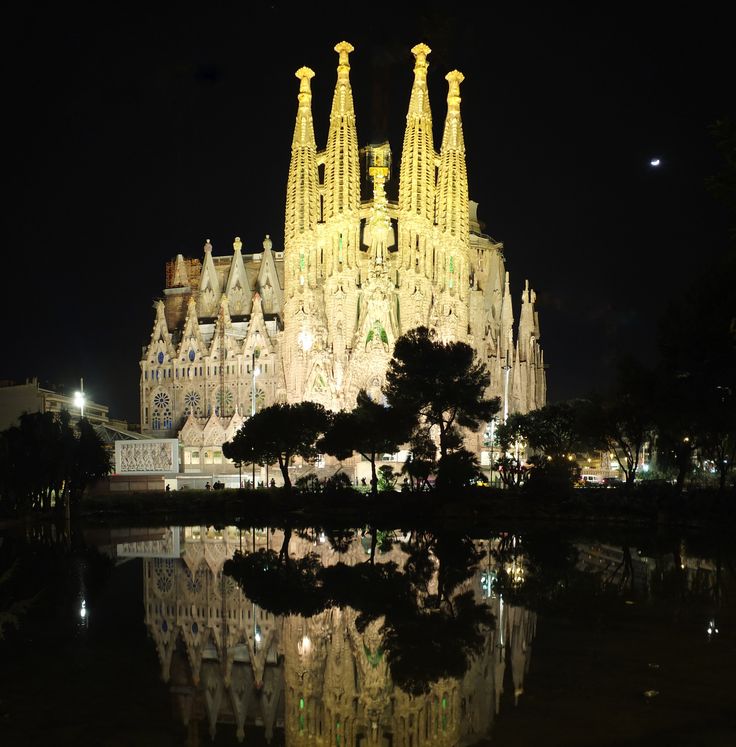
Also Read: 10 Remarkable Art Nouveau Buildings Mastered by Gaudí
2. It all started with a bookseller…..and another architect
©Renate Dodell
Josep Maria Bocabella, on his visit to the Vatican, wanted a church to be built in Spain, similar to the ones he had seen in Italy. Funded by private donations, construction started in 1882 under the architect Francisco Paula del Villar. If it continued under him, Sagrada Familia would have been a standard Gothic revival church.
However, he resigned a year later, and Antoni Gaudi took over. With only the apse crypt completed, Gaudi radically changed the plans, and the Sagrada Familia of today was born.
3. Pure and Geometric
Ground Level Plan
Gaudi’s design for the church was done with the forethought that any architect who came after him could understand the drawings and details and continue the construction.
Moreover, as he knew that the church wouldn’t be completed in his lifetime, he planned the construction in stages. This was done so that architects of different periods could add their style to the church’s design.
Also Read: 10 of the Most Iconic Buildings of Modern Architecture
4. Façades and Symbolism
Photography by © amazinao
Out of the three main façades, the east (in reality, North East, but has been simplified) façade, also known as the Nativity façade, is the only one to be constructed under Gaudi’s watchful eye. The Passion Façade (simplified West) is built and open to visitors, while the Glory façade (simplified south) is still under construction.
The Nativity façade, which celebrates the birth of Christ, has three portals – Hope, Mercy, and Faith. The faces on the Portal of Mercy were done using the death masks of the deceased people of Barcelona and molds of the workers’ faces.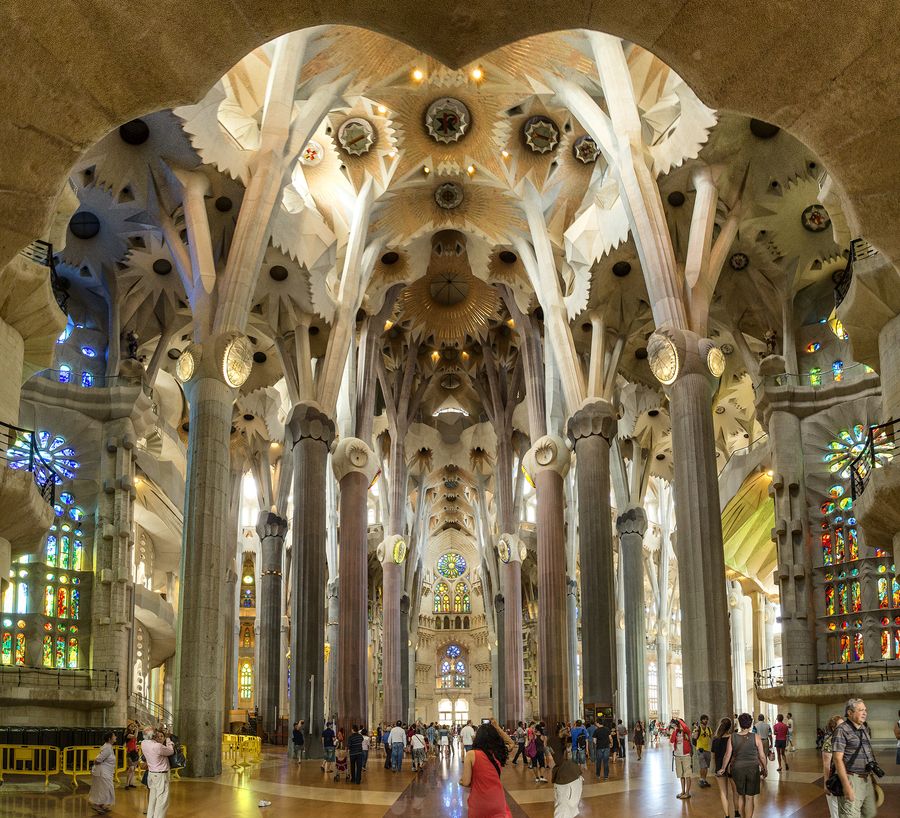
Detail of the Nativity Facade ©Famke Veenstra
The Passion façade is dedicated to the death of Christ and is designed to be plain and simple. With rigid shapes, harsh lines, and composed of bare stone, the facade is representative of a skeleton. This façade has fewer sculptures in comparison to the Nativity façades. Scenes from The Last Supper, Judas’ kiss, the crucifixion, and the resurrection are depicted. It has six large and inclined columns to resemble the Sequoia trunks. Above this are 18 smaller white columns representing bones.
©John Kennan
The Glory façade, after construction, will be the tallest and principal facade of Sagrada Familia. It offers access to the nave and will be decorated with idols, false gods, and demons.
5. 12 Towers with multiple pinnacles
2003 ©Expiatory Temple of the Sagrada Família
Each façade consists of 4 towers (a total of 12 towers) representing the Apostles of Jesus Christ.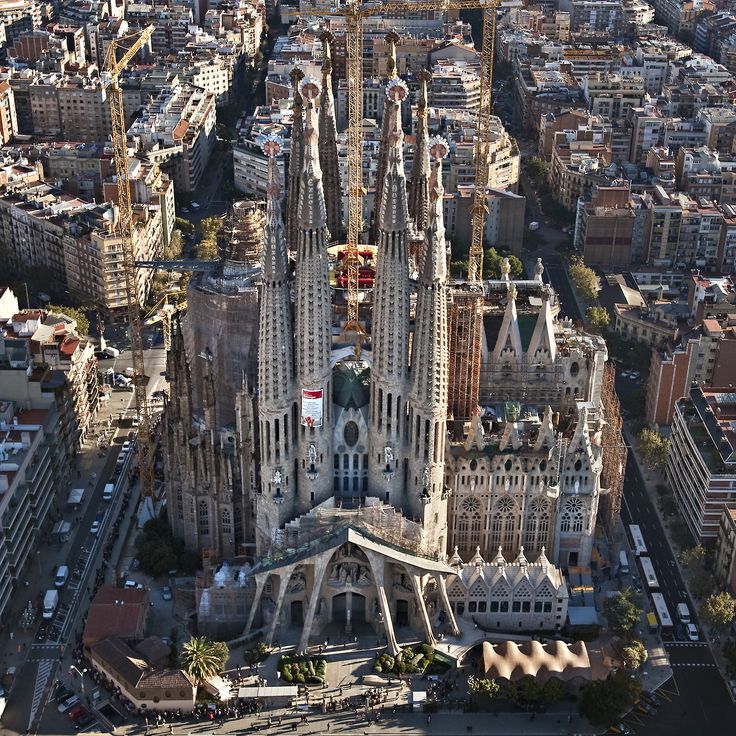
The 6th tower is at the very north and shorter than the ones representing the Evangelists. However, it is more sturdy and depicts the Virgin Mary. The tower of Jesus will be topped with a cross, while the other buildings will have different symbols. The towers of the three main façades will have episcopal symbols. Apart from the 18 towers, the church has other smaller pinnacles. These have other religious symbols on top of them, like sheaves of wheat, a bunch of grapes, etc., representing the Eucharist.
6. Nature and God’s Work
Construction of the aisle vaults, 1997 ©Expiatory Temple of the Sagrada Família
Gaudi is known for getting inspired by Nature, his buildings having numerous nods to nature’s bounty.
The interiors of Sagrada Familia are designed to represent Nature, with columns as trees and various creatures hidden throughout the basilica. Moreover, he believed that the work of humans should not exceed the work of God and designed the central tower to be a meter shorter than the Montjuic hill of Barcelona.
7. Magic Square on the Passion Façade
Construction of the apse walls completed 1893 ©Expiatory Temple of the Sagrada Família.
As though from a Dan Brown book, the Passion façade has a 4×4 Magic Square that has puzzled everyone. Some had found that the magic constant (the sum of the numbers in a row/column) was 33 – the age of Christ when he was crucified. Others explain the 33 as a part of Gaudi’s Freemanson history. Gaudi seems to have taken the secret of the magic square to his tomb, leaving everyone to theorize and devise conspiracies.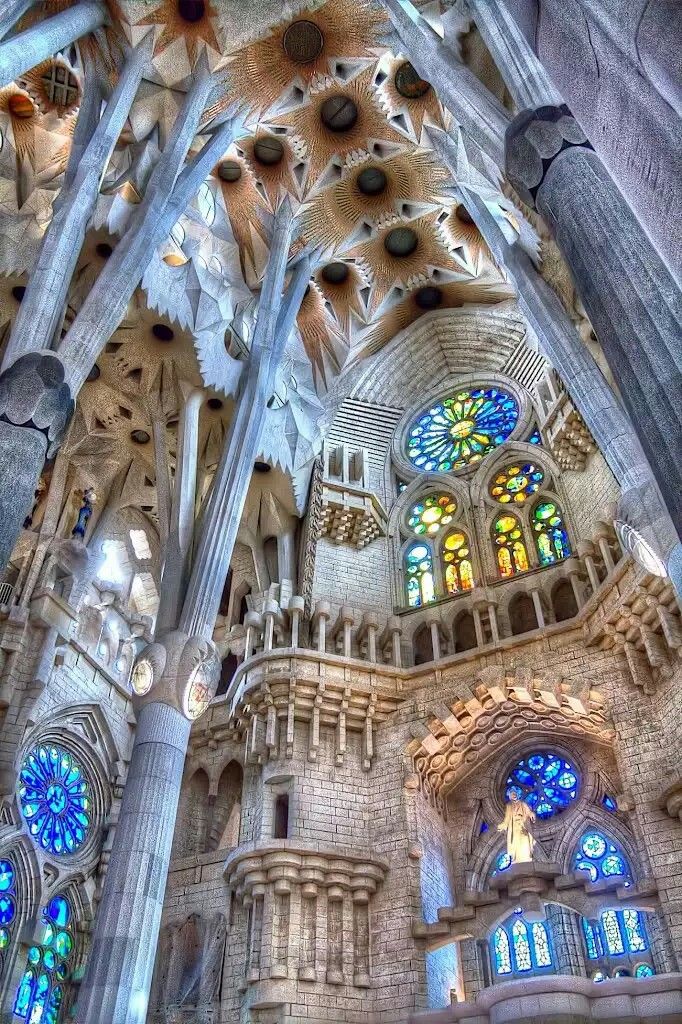
8. Not everyone is a fan
©John Kennan
Criticisms from writer George Orwell – who called the church “one of the most hideous buildings in the world” – and British historian Gerald Brenan “Not even in the European architecture of the period can one discover anything so vulgar or pretentious” should come as no surprise. With bold style, Sagrada Familia is bound to ruffle a few feathers.
Moreover, in 1936, a bunch of anarchists broke into the church and set alight all the models and papers made by Gaudi. Architects like Francesc Quintana, Isidre Puig, and Luis Bonet had to combine the remaining design materials and imagine Gaudi’s vision of Sagrada Familia. In 2008, over 100 members of Barcelona’s art and architecture community signed a manifesto stating all the project’s parts that were straying from Gaudi’s style.
9. Sagrada Familia’s crypt: Who is buried in Sagrada Familia?
©daphne.ph
Only two people are buried there – its architect, Antoni Gaudi, and the man who started it all, Bocobella.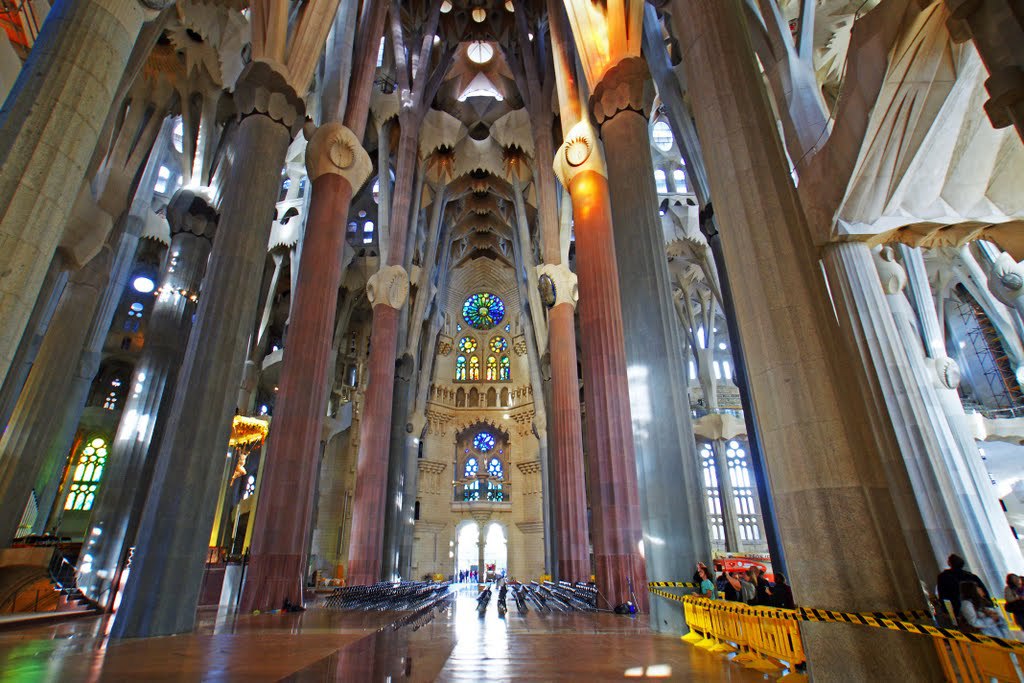
10. Doubles as a Lighthouse
©Expiatory Temple of the Sagrada Família
The mosaic on the roof of Sagrada Familia is designed to reflect the moonlight. It turns into a kind of lighthouse to guide seamen back home. Moreover, the reflection of the roof in the sun is so that the structure is visible from all points of the city.
12. Donations, Alms, and Tourists for construction
The Nativity Facade ©Expiatory Temple of the Sagrada Família
The construction of Sagrada Familia is entirely dependent on private funding. It received the name Expiatory Temple because the government or the church did not support the building. Approximately €25 million a year’s budget is entirely obtained through entrance tickets to the church and private donations.
You could also visit this beautiful UNESCO Heritage Site and proudly call yourself a contributor to the construction of Sagrada Familia.
Why is the Sagrada Família not finished?
©Fundació Junta Constructora de la Sagrada Família
Gaudi’s tragic death was one of the first to interrupt the church’s construction.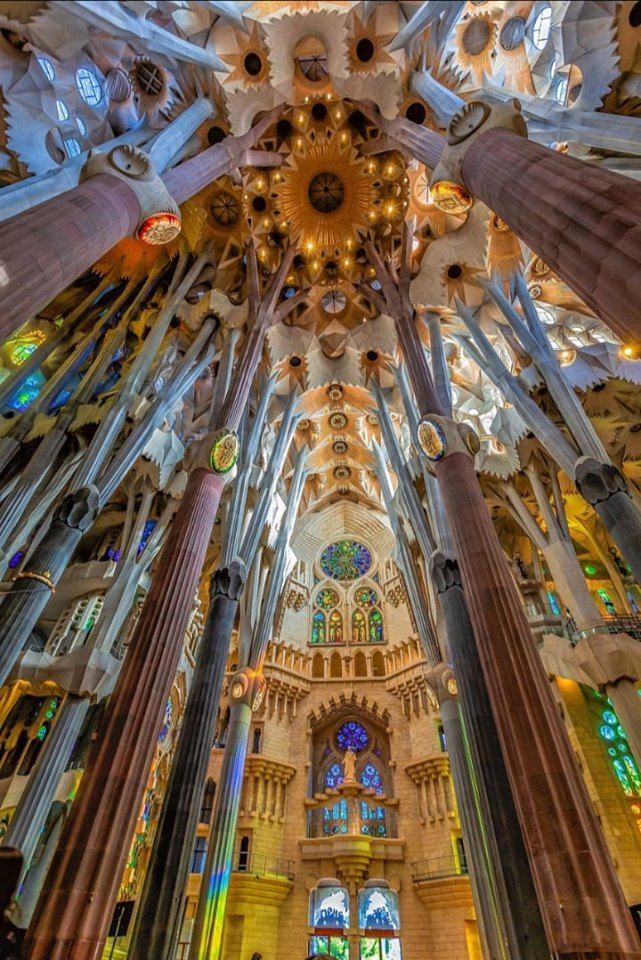
The building of Sagrada Familia gained steam throughout the years, only to be momentarily delayed again in March 2020 owing to the Covid-19 pandemic. However, in July 2020, the basilica reopened to its most important employees, and since then, progress towards finishing Sagrada Familia has been encouraging.
There have been five generations of people who have seen the basilica take shape. Completing this one-of-a-kind extravaganza in 2026, on the centennial of Gaudi’s death, is a poetic coincidence.
- The Passion Facade © Expiatory Temple of the Sagrada Família
- The Passion Facade © Expiatory Temple of the Sagrada Família
- Detail of the Passion Facade doors © Todd Heiden
- Detail of the Passion Facade © Renate Dodell
- Photography by © Renate Dodell
- Photography by © Renate Dodell
- Photography by © John Kennan
- Photography by © John Kennan
- Photography by © John Kennan
- Photography by © Expiatory Temple of the Sagrada Família
- Photography by © Expiatory Temple of the Sagrada Família
- The Choir © Expiatory Temple of the Sagrada Família
- Photography by © Jose Gonzalvo
- Detail of the Nativity Facade © Famke Veenstra
- Passion Facade sculpture © Eugene Zhukovsky
- The Crypt © Expiatory Temple of the Sagrada Família
- Photography by © amazinao
- 2005 © Expiatory Temple of the Sagrada Família
- 2003 © Expiatory Temple of the Sagrada Família
- Construction of the central towers, 2007 © Todd Heiden
- The Nativity Facade © Expiatory Temple of the Sagrada Família
- 2002 © Expiatory Temple of the Sagrada Família
- Construction of the aisle vaults, 1997 © Expiatory Temple of the Sagrada Família
- 1995 © Expiatory Temple of the Sagrada Família
- 1992 © Expiatory Temple of the Sagrada Família
- 1974 © Expiatory Temple of the Sagrada Família
- 1925 © Expiatory Temple of the Sagrada Família
- Construction of the apse walls completed 1893 © Expiatory Temple of the Sagrada Família
- Longitudinal Section
- Ground Level Plan
- ©Expiatory Temple of the Sagrada Família
-
©daphne.
ph
- ©vistapointe.net
- ©Fundació Junta Constructora de la Sagrada Família
Basílica de la Sagrada Familia, Barcelona
Detailed Reviews: Reviews order informed by descriptiveness of user-identified themes such as cleanliness, atmosphere, general tips and location information.
Popular mentions
4.5
166,147 reviews
Excellent
129,508
Very good
26,357
Average
Terrible
Taha Boutorabi
Australia4 contributions
great piece of art
Jan 2023 • Solo
Amazing architecture and definitely worth a visit. Also so cool watching it at nights. Enjoyed my visit.
Written April 22, 2023
This review is the subjective opinion of a Tripadvisor member and not of Tripadvisor LLC. Tripadvisor performs checks on reviews.
Eaton_Out
Greenville, SC494 contributions
Barcelona Must-See
Apr 2023 • Couples
Our tickets were pre-purchased and required 2 pm entry.
Review of: Skip the Line: Basilica of the Sagrada Familia Admission Ticket with Audio Guide
Written April 22, 2023
This review is the subjective opinion of a Tripadvisor member and not of Tripadvisor LLC.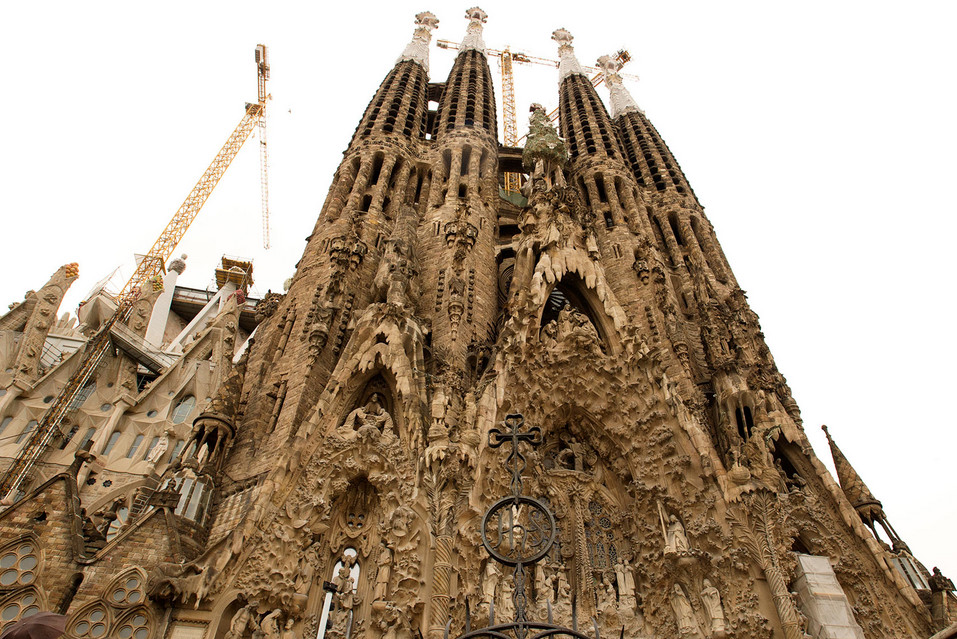
Cole D
Devon, UK9 contributions
Barcelona’s finest building!
Apr 2023
What a piece of architecture! Wow! An absolute must see in Barcelona! Definitely the first thing on your Barcelona city break to-do list for sure! Stunning inside and the museum below is very interesting reading about how it was built and the tributes Gaudi! Very busy with tourists but thats to be expected so make sure you’ve booked in advance to ensure you get in. 5/5!
Written April 21, 2023
This review is the subjective opinion of a Tripadvisor member and not of Tripadvisor LLC. Tripadvisor performs checks on reviews.
A Midlife Adventure
Dursley, UK1,004 contributions
Just awe inspiring
Apr 2023 • Couples
This is a must see whilst in Barcelona.
I would recommend you definitely book in advance and then arrive 30 mins before your assigned time as the queues were bad even in April.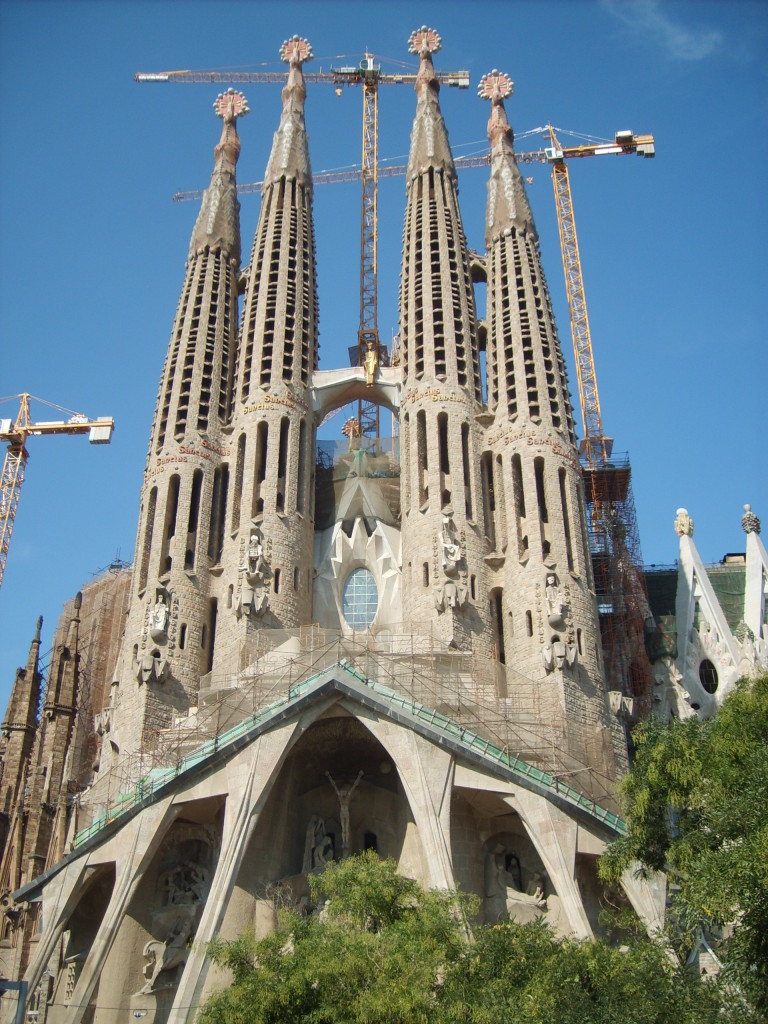
We are not the type to join a group tour but I did pick up an audio guide which I found really easy to follow and informative.
Once you are inside the gates you have to contend with the many group tours who all begin their visit outside but I still managed to follow my audio guide and grab a few photos.
Once inside the sheer volume of the space means the amount of tourists dissipates and you are so awe struck by this masterpiece of architectural engineering by the King of Modernist architecture Gaudi that everything else dwindles in comparison.
Everywhere you look: the beautiful light bouncing through the stained glass, the totally unique altar, even the staircases in the corners spiralling upwards are just so well thought out you cannot help to be amazed.
Finally the museum at the end of your walk is worth paying a visit. It gives greater insight not only into how Gaudi planned this church but also what is left to be completed.
Written April 21, 2023
This review is the subjective opinion of a Tripadvisor member and not of Tripadvisor LLC.
KenSML
Smith Mountain Lake, VA113 contributions
Wow
Apr 2023 • Couples
Having seen dozens of cathedrals and churches in Europe over the years, this was by far the most memorable. The interior is breathtaking: light and airy, colorful and surprising. You can’t come to Barcelona and not see this basilica.
Written April 20, 2023
This review is the subjective opinion of a Tripadvisor member and not of Tripadvisor LLC. Tripadvisor performs checks on reviews.
Nassia K
12 contributions
Breathtaking!
Apr 2023
awesome and breathtaking! the facades, their symbolism, the towers, the materials, everything…
Even my 6 year old was astonished when listening to the details!
Written April 20, 2023
This review is the subjective opinion of a Tripadvisor member and not of Tripadvisor LLC. Tripadvisor performs checks on reviews.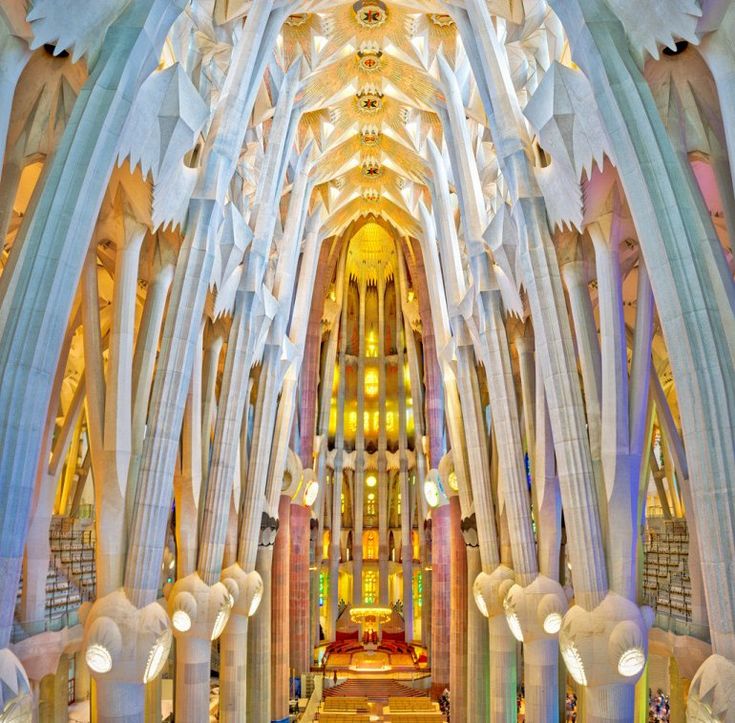
gringottsgoblin
dublin319 contributions
Possibly my favourite building in the world
May 2022 • Couples
Words literally cannot do justice to this, Gaudi’s masterpiece. It is awe inspiring. There is literally nothing else like it anywhere. The outside is a soaring stupendous mountain of a building. My late father (an architect) adored the place too and even though he loved it, he got great fun out of saying the towers looked like enormous termite hills that grew out of a gothic cathedral. You have to admit that’s a bizzare image but I kinda agree. The detail is incredible and I could spend literally hours sitting outside admiring it. But architecture is not just about the outside. It’s fundamentally about the space and light inside and OMG Sagrada Familia is the ultimate expression of this. Even though I am familiar with so much of this church, I am still surprised and awe struck with the interior. It’s like so many gothic cathedrals in its feeling but goes a step further.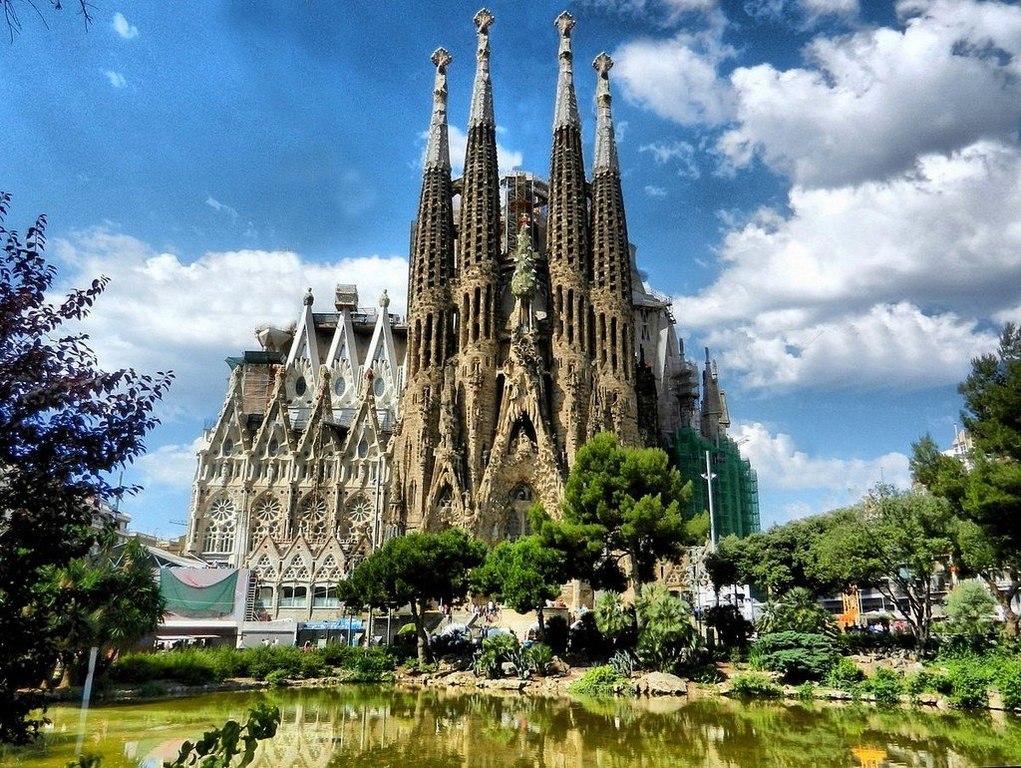
Written April 20, 2023
This review is the subjective opinion of a Tripadvisor member and not of Tripadvisor LLC. Tripadvisor performs checks on reviews.
Andrew B
2 contributions
A must do in Barcelona
Apr 2023
Must go. Do the tours if you are reasonably mobile.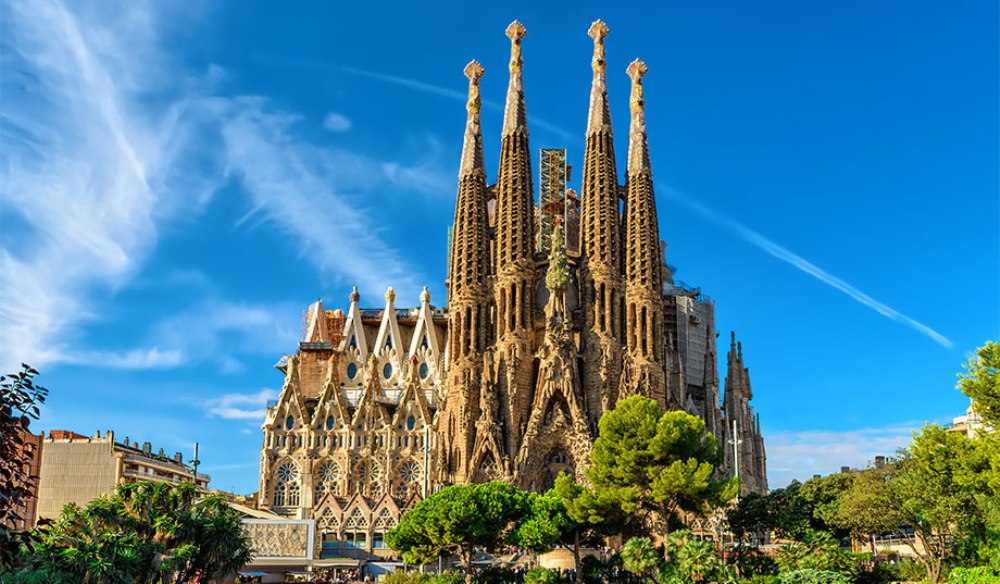
Written April 19, 2023
This review is the subjective opinion of a Tripadvisor member and not of Tripadvisor LLC. Tripadvisor performs checks on reviews.
kris-goes-places
260 contributions
Definitely Take a Look
Apr 2023 • Couples
Full disclosure: we didn’t do a tour so didn’t go inside. If you want to do that you need to book tickets in advance and be prepared for it to be very busy. We just went for a walk around it, just to see it. If you’re not into the tour itself, I would highly recommend doing a walk around! There is plenty to see just on the outside, and there is lots of activity in the streets and the nearby park. The architecture is a photographer’s dream. It is a truly unique building that you will want to say you have seen.
Written April 17, 2023
This review is the subjective opinion of a Tripadvisor member and not of Tripadvisor LLC.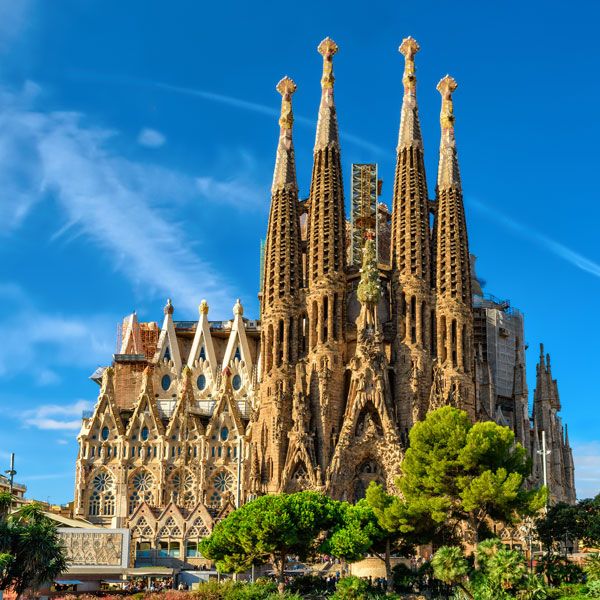
Janet
Stockport, UK7 contributions
Prebook to avoid the crowds.
Mar 2023 • Friends
Just breathe taking. Sadly, though, had to navigate through hoards of wannabee ‘influencers’ being photographed. Extraordinarily disrespectful in a church and I’m astonished that this is not forbidden.
Written April 17, 2023
This review is the subjective opinion of a Tripadvisor member and not of Tripadvisor LLC. Tripadvisor performs checks on reviews.
Showing results 1-10 of 76,548
Sagrada Familia in Barcelona
A grand creation. A masterpiece of architecture. Music frozen in stone… A huge number of admiring words have been said about the Sagrada Familia temple. This is perhaps one of the most unusual temples in Europe. For some, its bizarre silhouette resembles a sand castle, for others it looks like a fairytale forest, and for others it looks like a gigantic mountain, in the caves of which stalactites-bell towers grow, and grottoes-portals lead into the mysterious depths.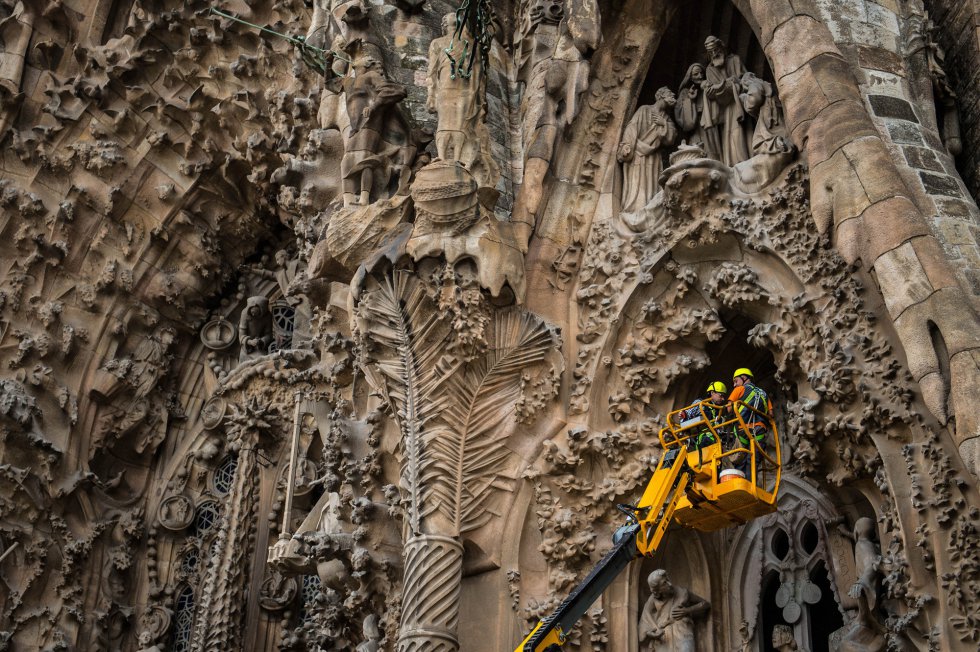
Contents:
The construction of the Sagrada Familia: how it all began
Gaudí’s ingenious project
Interior of the Sagrada Familia
Interesting facts about Sagrada Familia
Practical Information
Video Sagrada Familia: Animated 3-D Model
Sagrada Familia on the map of Barcelona
Construction of the Sagrada Familia: how it all began
The construction of the Sagrada Familia began at the end of the 19th century. In 1866, the Catalan bookseller José María Bocabella founded the Society of the Venerators of Saint Joseph, a movement of lay believers who advocated the preservation of traditional values.
The foundation stone of the Sagrada Familia was laid on March 19, 1882, then outside the city limits of Barcelona, in the Barrio del Poblet, an area on the site of the current Eixample quarter. It is noteworthy that the construction has always been carried out exclusively on private donations.
During the long history of this “protracted construction”, several masters worked on the project, among which the name of Antonio Gaudi stands apart. Few people know about this, but initially the project was led by another architect, Francisco del Villara. He had disagreements with customers, and six months after the start of construction of the Sagrada Familia, he was headed by Gaudi.
It is noteworthy that when Gaudi, on the recommendation of the architect Joan Martorel, was offered this job, he was 30 and a little-known graduate of the High School of Architecture. There is a legend that the builder allegedly dreamed that the temple would be built by a man with blue eyes. Blue-eyed, red-haired Antonio differed sharply from his dark-eyed and dark-haired compatriots. Perhaps it was these “irresistible eyes of the prophet”, as they later said about them, that made an impression on Bocabella.
Gaudí’s ingenious project
When Gaudí landed the job of his dreams, he immediately thought big. His creation was supposed to be something grandiose and certainly not like anything else. To begin with, he almost completely changed the project of his predecessor, leaving only one thing – a Latin cross was placed at the base of the church. In addition, he completed the crypt begun by Villar. And everything else has been radically changed.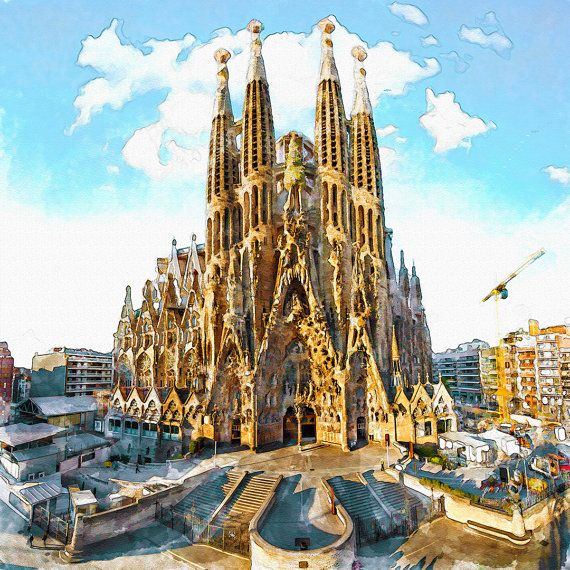
Gaudí’s plans were to build three facades, each of which was supposed to illustrate one of the three most important gospel episodes: the Nativity, the Passion of Christ and the Ascension (facade of Glory). On each of the facades, it was planned to create a large portal with three doors, topped with four towers.
According to Gaudí’s project, 18 towers should rise above the cathedral, and each of them is symbolic. 12 towers are dedicated to the apostles, 4 towering above them – to the evangelists, the highest – to Jesus Christ, and another one standing just below it – to the Virgin Mary.
As befits geniuses, Gaudi was distinguished by unconventional thinking. What he conceived and what he made sketches and layouts could only be repeated in our time with the help of the most modern computer technologies. The architect practically lived in the temple during construction, constantly thinking about his project, literally gushing with ideas, changing a lot more in the course of work.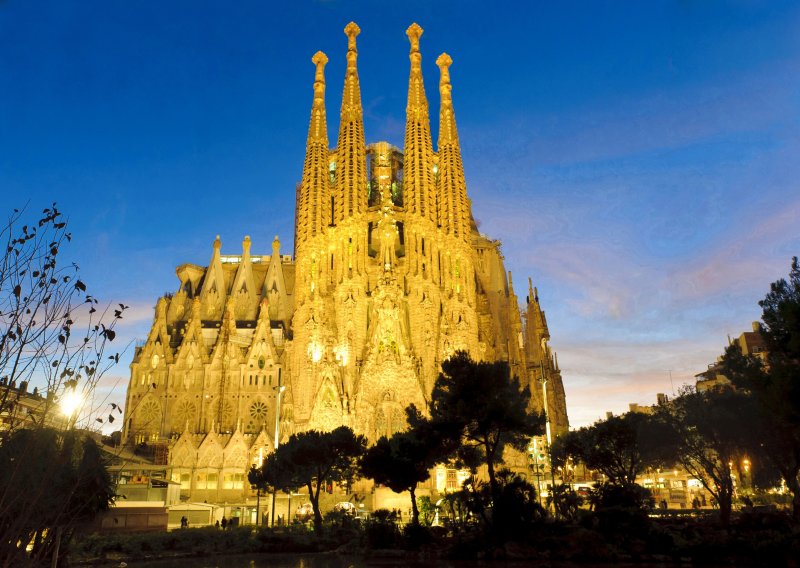
The famous long-term construction
The construction of the Sagrada Familia
The Spanish Civil War added to the problems: when the insurgent anarchists burned the workshops in 1936, many of the sketches that remained after the departure of the master were lost. Gaudi’s brilliant ideas had to be restored literally like pieces of a mosaic – according to the sketches left by the students, photographs of the layouts.
Work resumed only in 1944, after which they stopped again more than once – either due to lack of funding, or because of the need to clarify Gaudí’s ideas.
For more than a century, the Sagrada Familia remained an unconsecrated temple, that is, all this time services could not be held here. The temple was consecrated only on November 7, 2010, personally by Pope Benedict XVI.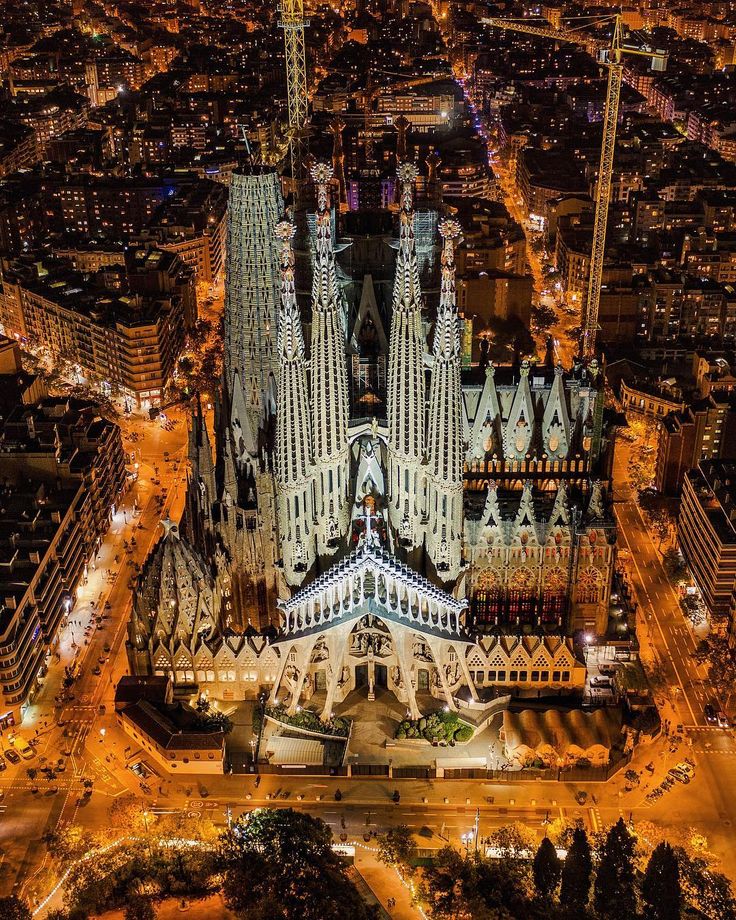
However, to this day the Sagrada Familia is in the woods. Now work is underway to decorate the facade of Glory, the creation of which began only in 2000. It is planned that the cathedral will appear in all its glory by 2026, the centenary of the death of Antonio Gaudí.
By the way, Antonio Gaudí himself is buried here, in the cathedral, to which he devoted several decades of his life. The place of his rest was an underground crypt under the altar. The entrance to the crypt is closed.
Bible in stone
Facade decoration of the Sagrada Familia
A distinctive feature of the Gaudi style is a harmonious and bizarre combination of natural and man-made beauty, when architectural forms are inspired by nature itself. At the same time, the architect never tried to conquer or surpass nature, considering it to be the creation of God. When designing the central spire of the Sagrada Familia, Gaudi made it 3 cm lower than the nearby mountain of Montjuic – 170 m.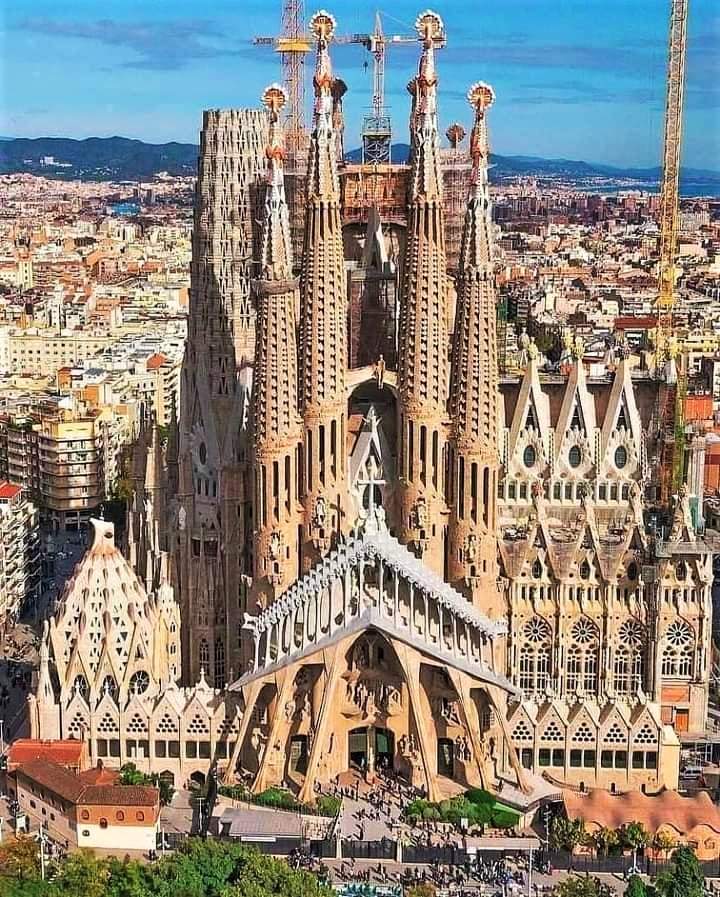
The design of the Sagrada Familia temple is permeated with symbolism. Every detail of this grand structure, from the base to the spiers of the towers, has a certain meaning, sometimes encrypted in religious symbols. For Gaudi, it was not just a church, but a grandiose “book” created in stone. And all spectators and visitors are called to read it, who freeze with admiration, looking at the majestic building. True, it is not always easy to “read” this stone “book” on your own. No wonder the researchers of Antoni Gaudí’s work, who are hard at work deciphering the symbols of the master!
In order for you to pay attention to the most interesting details in the design of the cathedral, and at the same time learn a lot of interesting things about its history, about the life of Gaudí himself, as well as about other amazing buildings in Barcelona, we have created an audio guide “Masterpieces of Modernism”.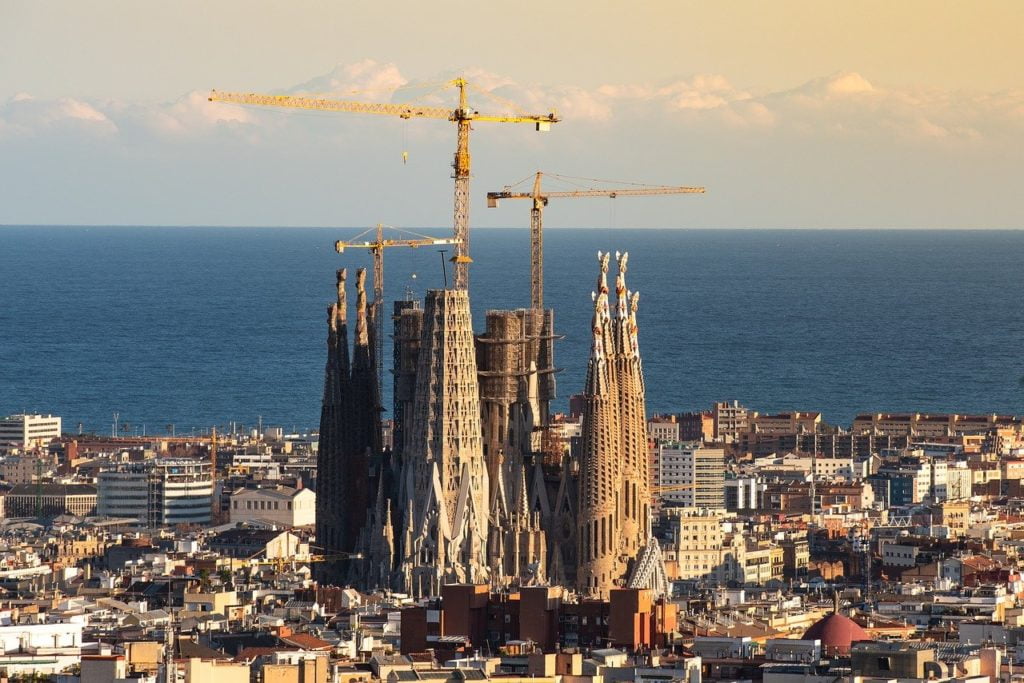
Three facades
The first and only facade, the work on which was generally completed during the life of Gaudi, was Nativity facade with spindle-shaped bell towers. He is the brightest and most joyful. Its gates are richly decorated with stucco with plant and animal motifs – stone plants, flowers, birds, insects, animals. As if all nature meets the Savior who came into the world, who was born in a manger. Above the portal, in a sculptural group, the Holy Family itself is also depicted (in Spanish – Sagrada Familia).
The Nativity facade tells the story of the birth of Christ – from the betrothal of Mary and Joseph and the flight to Egypt until the birth of Christ, when the angels announced to the shepherds the birth of the Savior. It is crowned with a cypress tree surrounded by birds – a symbol of the Church and her flock.
On the opposite side of the Nativity façade is the Passion façade .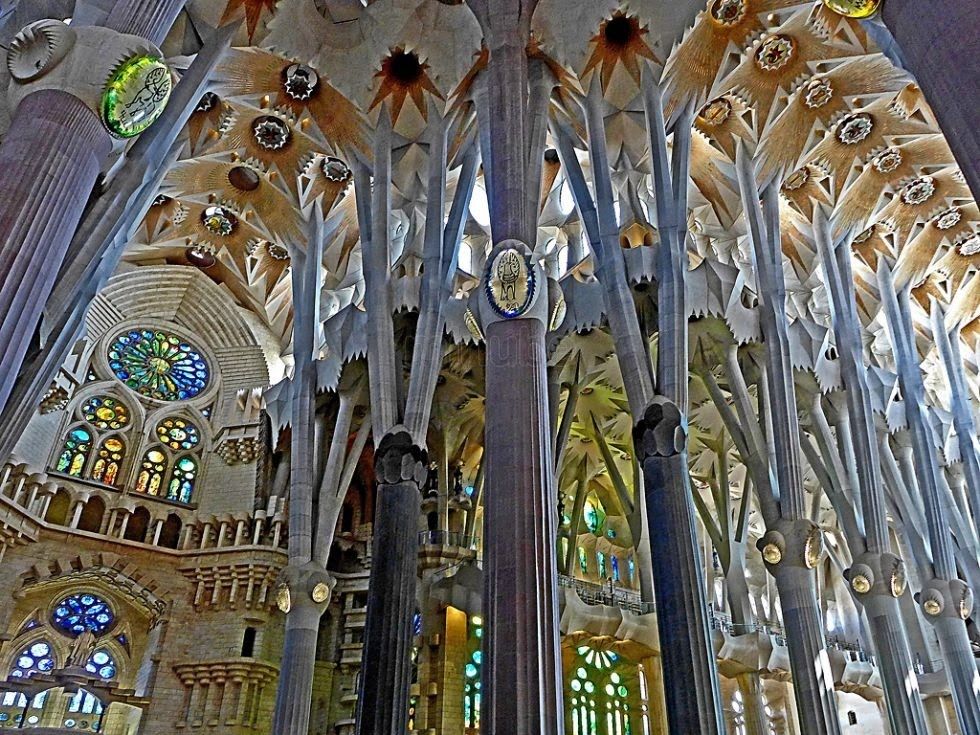
Facade of the Passion of Christ in the Sagrada Familia
Completes this architectural “trilogy”, according to Gaudí’s idea, Facade of Glory. Work on it is still ongoing. The plot for the design of this facade of the Sagrada Familia will be the history of mankind in the eternal confrontation between sins and virtues.
Interior of the Sagrada Familia
The interior design of the church is no less impressive than the exterior.
Sagrada Familia inside
In developing the interior layout, Gaudí used fundamentally new solutions. There are practically no straight lines in the temple. It is today that we call those forms that underlie the design of the temple hyperboloid, paraboloid, helicoid, conoid, etc. Gaudi “borrowed” all these forms from nature, making them the main columns, walls and various elements of the temple.
Surprising in the interior of the Sagrada Familia is the fact that the main load falls on the columns that distribute the weight of the towers and vaults.
Interesting facts about the Sagrada Familia
Illegal building
During the 136 years of its construction, was the Sagrada Familia an illegal building? Only in October 2018, after two years of negotiations with the Barcelona City Hall, its trustees received a building license. According to the agreement, the city authorities will receive 36 million euros as a fine, which will be used to improve the infrastructure around the temple.
Crocodiles on the temple walls
On the walls of the facades of the Sagrada Familia, you can see images of many animals. Among them are even crocodiles.
Striving for naturalism
Sometimes Gaudi turned to unexpected ways to achieve the perfect result. In the tragic scene of the beating of the Bethlehem babies, the architect strove for maximum naturalism. That is why he even made plaster casts from deadborn babies.
Magic square
In the design of the Passion facade, attentive observers notice an unusual cryptogram – a square with numbers. It encodes the age of Christ at the time of the Crucifixion – 33 years. It is this figure that is obtained by adding the indicated numbers along any horizontal, any diagonal, or the sum of the number of the four central cells.
“Magic Square” on the facade of the Sagrada Familia
Portrait of Gaudí on the walls of the Sagrada Familia
It is unlikely that the ardent believer Gaudí himself would have allowed himself such impudence, but his followers and admirers really wanted to pay tribute to the great architect and portrayed him in the form of an evangelist elder.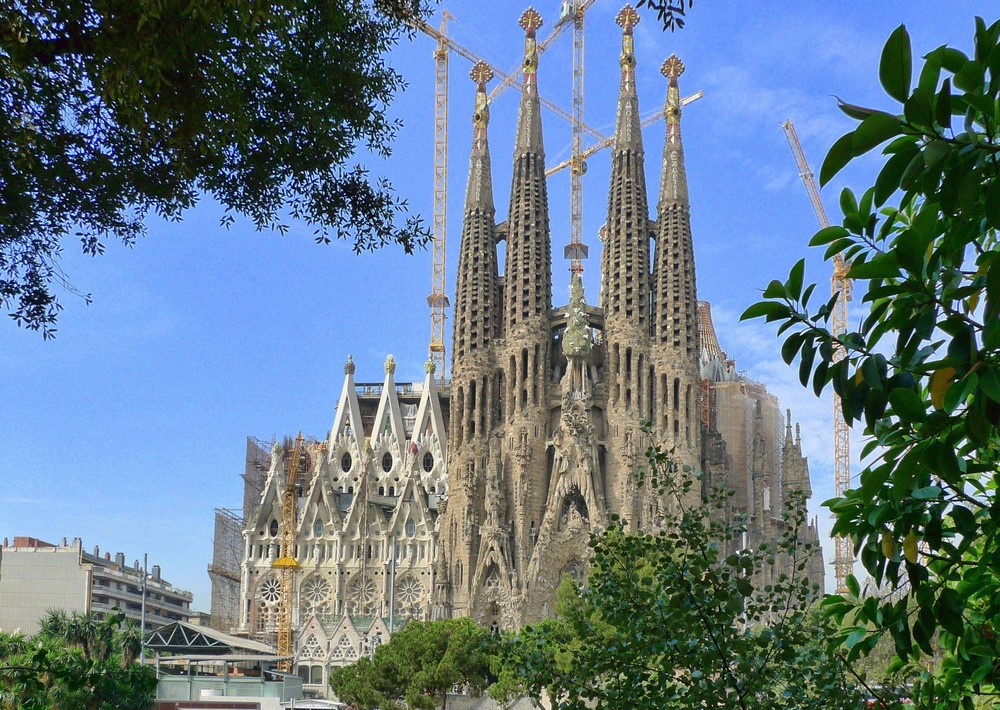
How the Sagrada Familia appears to the angels
The Sagrada Familia is crowned with soaring spiers, on which Gaudí worked for several years. “Why are you so worried about how they will look, because no one will see these spiers from the ground?” Gaudi was asked. “They will be looked at by angels,” the master answered.
“My client is in no hurry”
Gaudí was well aware that due to the grandeur of his plan, the temple would not be completed during his lifetime. Moreover, he assumed that the construction would take three centuries! So it is even ahead of schedule – the Catalan authorities promise that the temple will be completed in the next decade. But Gaudí did not try to rush and speed up the construction. And to reproaches of slowness he answered: “My client is in no hurry,” meaning the Lord.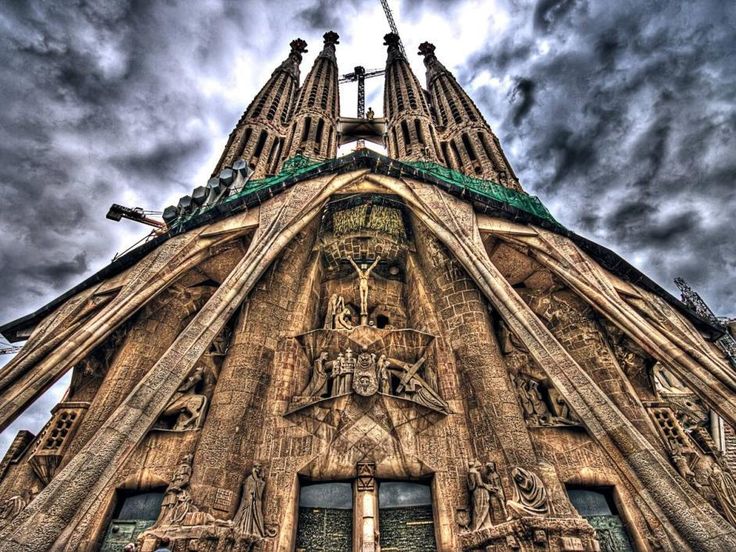
Sagrada Familia in Barcelona: practical information
How to get there
The nearest metro station, as well as a bus stop, is called Sagrada Família. Metro lines L2 (lilac) and L5 (blue) pass here, as well as bus routes 19, 33, 34, 43, 44, 50 and 51.
Opening hours
depending on the season:
from November to February – 9.00-18.00;
from March to October – 9.00-19.00;
from April to September – 9.00-20.00.
Ticket offices close half an hour before the basilica itself.
Opening hours may change due to holidays or special events. Check the official website for the exact opening hours and ticket prices.
How to skip the queue
To avoid queues and save money at the same time, purchase a ticket in advance online, on the official website. It will indicate the exact time of your visit – think in advance of the one that will be convenient for you and do not be late.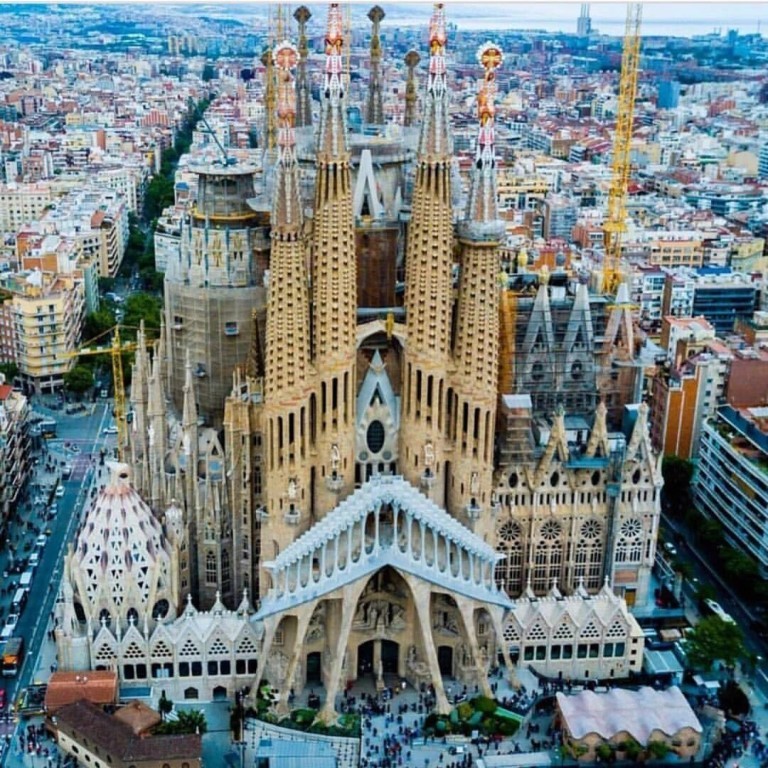
When is the best time to visit? And the best season to visit here is autumn-winter. During this period, there are not a large number of guests, and you can enjoy the temple in full without queues and hustle.
What else to look for
- The two accessible towers of the cathedral have observation decks from where you can admire Barcelona, in particular, the Eixample district (which we walk from by this audio tour).
- The Sagrada Familia has its own museum, located directly below the church. Its exposition tells about the history of construction and includes models and drawings.
- There are left-luggage offices at the Sagrada Familia Basilica. They put things in them before climbing the towers. A visit to the cathedral itself is allowed with small items.
Audio guide
The Sagrada Familia has its own audio guide (also available in Russian).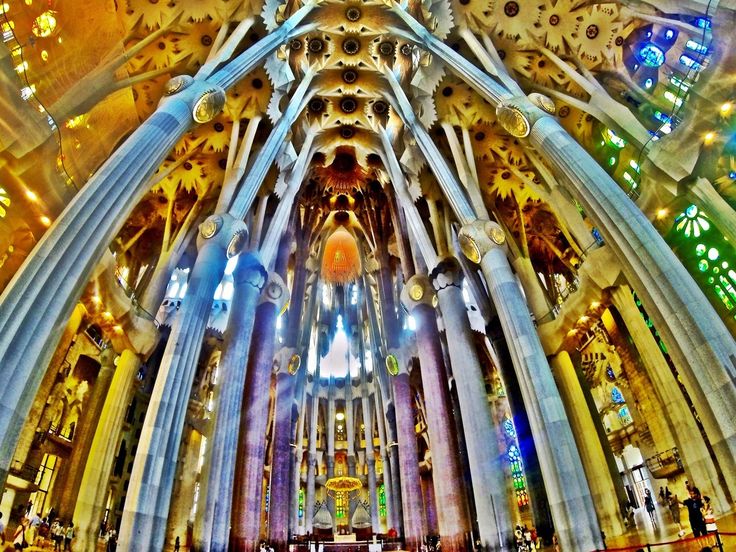
Read also:
Barcelona on your own: tips and secrets
Antoni Gaudí and Barcelona: freedom in stone 47
Sagrada Familia on the map of Barcelona
Barcelona hotels near Sagrada Familia
Sagrada Familia: the creation of a genius or a madman?
- Jonathan Glancy
- BBC Culture
Image credit: Thinkstock
When Sagrada Familia in Barcelona is completed, it will be the tallest church in the world.
“My client is in no hurry,” Antonio Gaudí often said, hinting that God has plenty of time. There is no need to rush to complete the main creation of the ambitious Catalan architect.
The Sagrada Familia is sometimes erroneously called Barcelona Cathedral, although another well-known church in the city bears this name – the Gothic Cathedral of the Holy Cross and Saint Eulalia, built in the 14th century.
Sagrada Familia Expiatory Church (that’s what the full name of the church sounds like) is being built entirely through private donations and ticket sales. More than 2.5 million tourists visit the Sagrada every year, although the construction of the temple has not yet been completed. The opening of the most long-awaited structure in the world is unlikely to happen before 2026.
Considering that the construction of the temple began in 1882, it will definitely become the creation not only of the great Gaudí, but also of several generations of dedicated professionals and enthusiasts.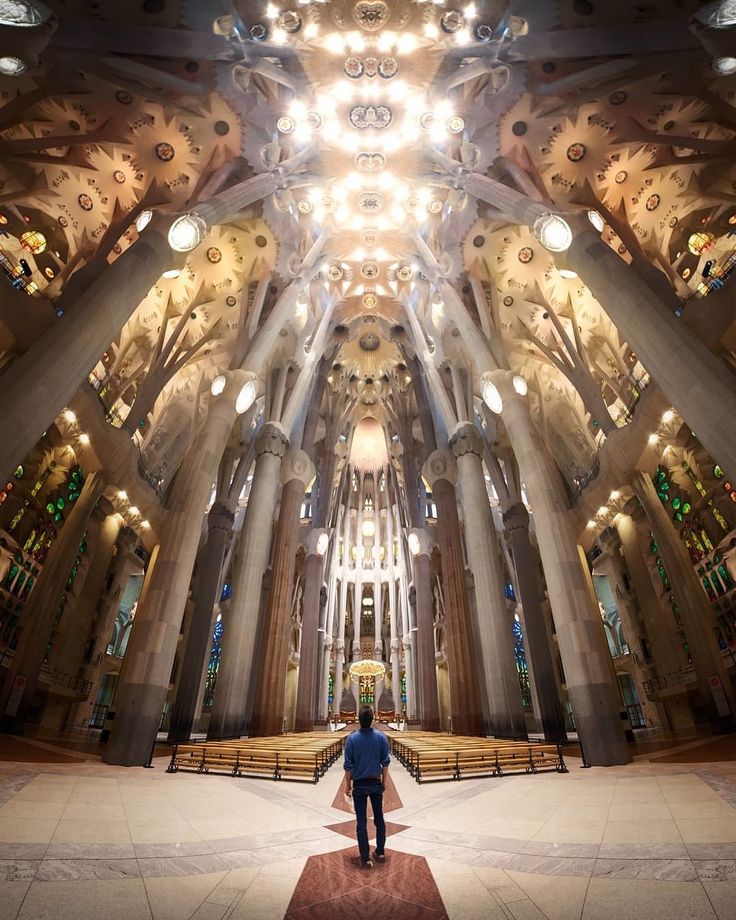
Image copyright, Thinkstock
Image caption,
Antonio Gaudí designed radical architectural forms far ahead of his time
When the last stone is set, Sagrada Familia will be the tallest church in the world, rising 170 meters above the Catalan capital. It will also be the most unusual, and possibly the most controversial, place of worship on this epic scale.
Looking down on the world, this giant termite mound, a petrified forest, a sand castle or a huge gingerbread house baked by the world’s most evil witch, this most ambitious project in the history of construction has begun to confuse architects, critics and historians ever since its unprecedented form structures became known – shortly after the First World War.
George Orwell called the Sagrada “the most disgusting building in the world” and even hoped a little that it would be destroyed during the Spanish Civil War. Salvador Dali spoke of its “terrible beauty and edible appearance” and insisted that the temple should be kept under a glass dome.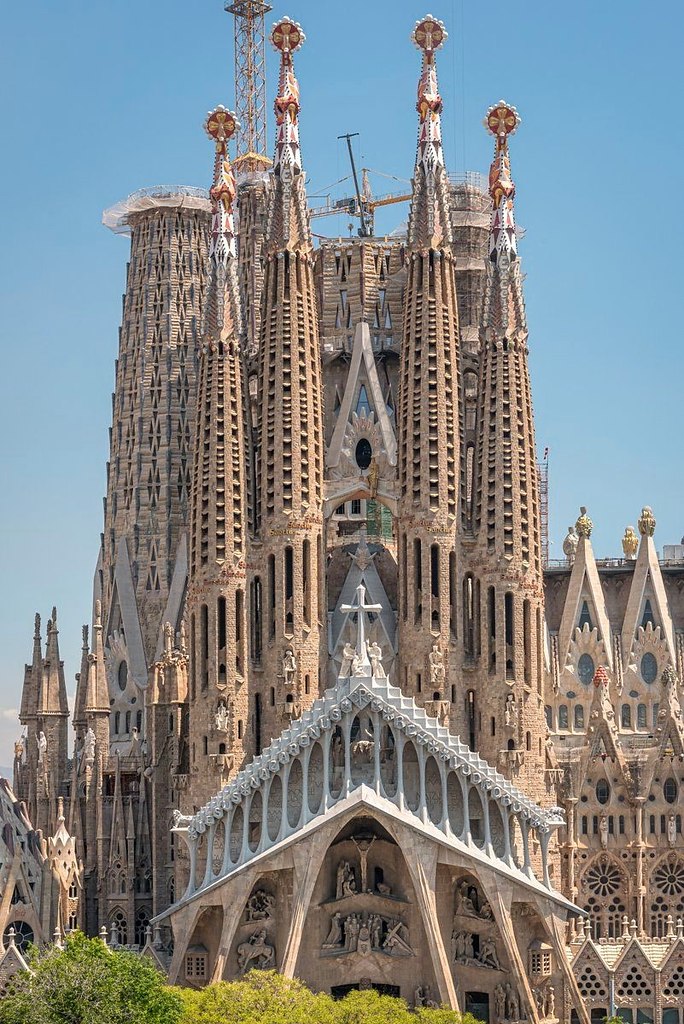
Image copyright, Thinkstock
Caption to photo,
George Orwell called the Sagrada “the most disgusting building in the world”
Walter Gropius, creator of rectangular architecture and founder of the Bauhaus (avant-garde trend in architecture), was fond of the technical perfection of the temple. An outstanding American architect and “father of skyscrapers” Louis Sullivan said that the Sagrada Familia is “a spirit frozen in stone.”
Tourist trap?
When the vault of the nave, 46 meters high, which overshadows the mind with its complex structure, was completed in 2010, and the basilica was consecrated by Pope Benedict XVI, the controversy around the temple began with renewed vigor.
Manuel Vicente, a columnist for the Madrid daily El Pais, commented, “Sagrada Familia’s only advantage is the fact that it is not yet completed. It is the work of a genius engulfed in mystical dreams.
Architect Enric Massip, a member of the Barcelona Advisory Committee, criticized the basilica, declaring that it was “artificially inflated” and “lacked spirituality”.
Image copyright, Thinkstock
Caption before photo,
The temple is the pinnacle of sophisticated mathematics and leading building technology
Interestingly, in 1990, Massip founded his own architectural workshop “with the aim of developing leading and innovative architectural thinking.” Although it is not very clear what exactly he meant by this expression – Enric Massip did not leave many notes or drawings – his phrase very accurately describes what Antoni Gaudí himself did when he designed radical architectural forms far ahead of his time.
Those who dislike the Sagrada Familia are not really able to see what lies behind its magnificent and, perhaps, somewhat chaotic external forms.
The design of the Sagrada is based on complex shapes that are known to us today (or should be known) under the names helicoid, hyperboloid and hyperbolic paraboloid. Gaudi borrows these forms from nature and lays the foundation for the construction of columns, vaults and ordinary geometric elements of the structure of the temple.
Examine the vault that crowns the nave of the basilica. Doesn’t it resemble a dense crown of trees through which sunlight breaks through? Gaudí hoped that we would see it this way. He said that all the elements of his design “come from the Big Book of Nature.” His “textbooks” were mountains and caves, which he loved to explore.
Image copyright, Hulton ArchiveGetty Images
Image caption,
Construction of Sagrada Familia began in 1882 and will not be completed until 2026
When 23-year-old New Zealander Marc Berry arrived in Barcelona in 1980 and, along with other architects, tried to put together the fragments that remained from Gaudí’s model of the temple, at first he could not understand their whimsical geometric shape.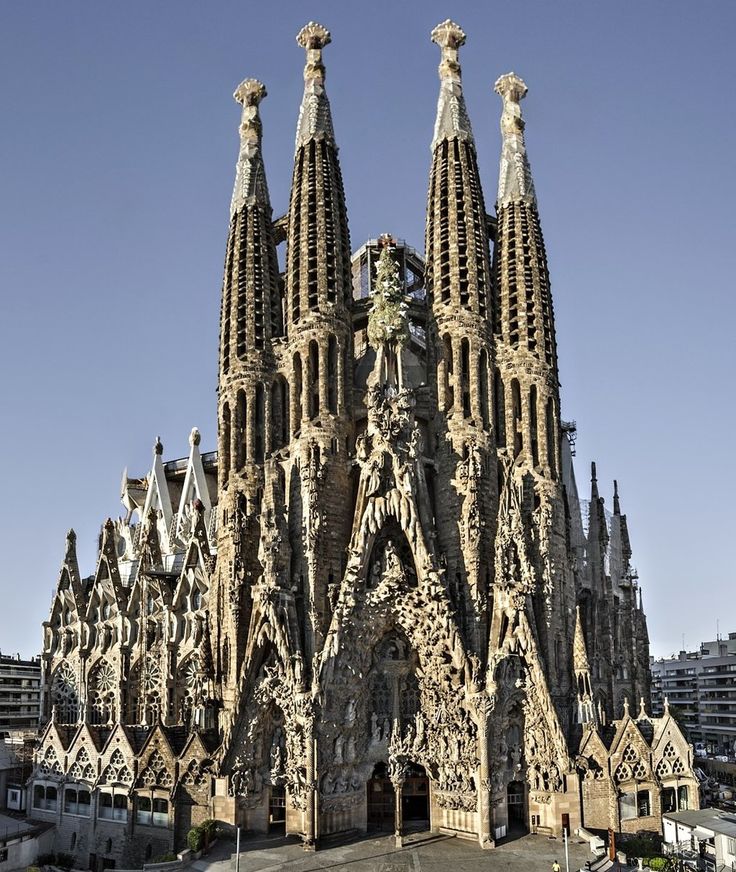
Subsequently, Berry received the position of Chief Executive Architect of the Sagrada Familia. He also became a leading specialist in spatial design and computer programming at the Royal Melbourne University of Technology.
Using parametric computer modeling techniques borrowed from the aerospace industry, Berry was able to complete Gaudí’s designs. Working under the guidance of Jordi Fauli and Olère, he was even able to speed up the construction process, as he began to use automated machines to cut the stone.
It never ceases to amaze Berry and his fellow architects how accurately Gaudí developed these complex three-dimensional mathematical models using only his imagination and intuition.
An architectural marvel?
The few drawings and sketches made by Gaudí himself were mostly destroyed by the Catalan anarchists who attacked the Sagrada Familia during the Spanish Civil War.
However, they left the tomb of the architect untouched. After all, whatever their resentment against General Franco and the Catholic Church, they knew well that Gaudí considered everything holy, regardless of social status and political beliefs.
On June 7, 1926, Antonio Gaudi hit a tram at the intersection of Carrer de Bailen and Gran Via in Barcelona. Taxi drivers refused to take the man to the hospital because they mistook him for a beggar.
Image copyright, Thinkstock
Image caption,
It never ceases to amaze architects with the precision with which Gaudí designed these complex 3D mathematical models using only his imagination and intuition. When he was found there, Gaudí refused to be transferred to another hospital. “My place is here,” he said. To say goodbye to the genius, thousands of people lined up on the streets of Barcelona.
Today it is difficult to understand the wave of religious feelings that inspired the creation of the Sagrada Familia.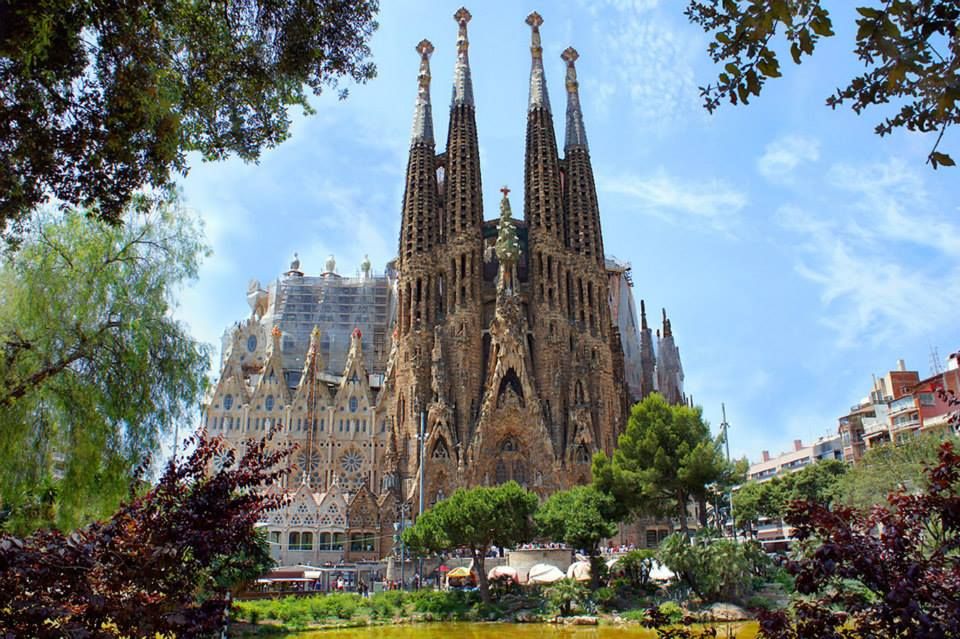
According to legend, in this building there was a house in which Archangel Gabriel appeared to the Most Holy Theotokos. To save Mary’s house from destruction in the 13th century, the angels moved it to Italy and hid it in Loreto.
Josep Bocabella founded the Society of the Devotees of Saint Joseph, which purchased land for the construction of the temple and paid for the work. At its peak, the Society had over 600,000 supporters. If faith in God can move mountains, it can certainly build Gaudí’s temple. Today, supporters of the famous architect are in favor of canonizing Antoni Gaudí.
Image copyright, Getty
Image caption,
Gaudí’s supporters are fighting to have the brilliant architect canonized
When completed, the Sagrada will have 18 spiers, 8 of which have already been built.

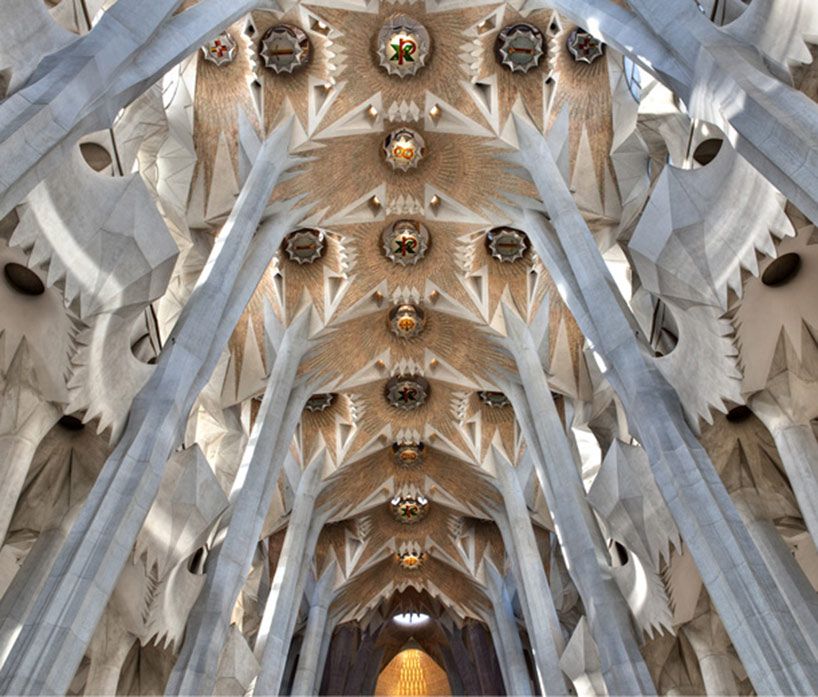 ph
ph
